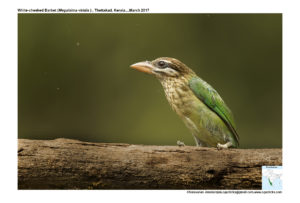White-cheeked Barbet

White-cheeked Barbet Megalaima viridis
Etymology:
- Megalaima: Greek word megalos- great; laimos- throat. { Great Throat}
- Viridis: Latin word for Green
Vernacular Names: Hindi: Chhota basanta, Guj: Nano lilo kansa, Kan: Sonna hasira barbet, Mar:Pandhrya galacha tambat/ Kuturga
They are tree dwelling fruit eating birds. They get their name from the bristles which fringe their heavy bills. They are also called as Small Green Barbet
Distribution in India: Resident Western Ghats and Hills of Tamilnadu
Description: Size of 23 cm; wt. of 71–90 g.. The head is brownish streaked with white, sometimes
giving it a capped appearance. The bill is pale pinkish. The other parts of body are green. Both the
sexes are similar. The immature is duller, browner or greyer, with patterns obscured and more lax
plumage.
Habitat: It is found in Evergreen forest, especially at clearings and edges, also pine forest, teak, sal
and deciduous forest.
Food Habits: They eat figs (Ficus) and other fruits, and berries, also flowers of pistachio (Pistacia
integgerima).They also eat nectar .During nesting period they are also known to eat Insects and
worms.
Breeding Habits: These birds are primary cavity nesters, chiseling out the trunk or a vertical branch
of tree with a round entry hole. . Both sexes excavate the nest and it can take about 20 days to
complete the nest .They breed from December to July, sometimes raising two broods. Favoured nest
trees in urban areas include Gulmohur (Delonix regia) and African tulip (Spathodea campanulata).
These nest holes may also be used as roosts. They may reuse the same nest tree each year but often
excavate a new entrance hole. They begin breeding in December and continue to nest until May.
This species is believed to form a pair bond that lasts for longer than a single breeding season.
Calling is intense during the courtship period. Courtship feeding of the female by the male is usual
prior to copulation. Calling intensity drops after the hatching of the eggs. Eggs are laid about 3–5
days after nest excavation. About 3 eggs are laid. The incubation period is 14 to 15 days. During the
day both sexes incubate, but at night, only the female sits on the eggs. Chicks are fed an insect rich
diet. The young leave the nest after 36 to 38 days.